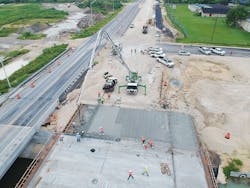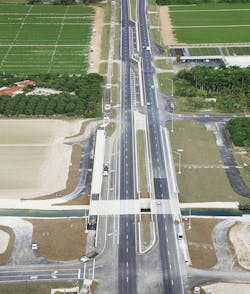Roadway project brings vital infrastructure improvements to western Miami-Dade community
The final phase of the 36-mile S.R. 997/Krome Avenue/SW 177 Avenue reconstruction and widening program, a long-planned Florida Department of Transportation (FDOT) District Six safety initiative, was completed in early 2021 by Halley Engineering Contractors Inc. after six years of overall construction along Krome Avenue in western Miami-Dade County.
This project included adding lanes and rehabilitating pavement along Krome Avenue from SW 312 Street/Campbell Drive to SW 296 Street and adding lanes and reconstructing along Krome Avenue from SW 296 Street to south of SW 232 Street. Krome Avenue is a heavily used north-south arterial and passes through a rural section of the county. Daily traffic includes residents, commuters, tourists, and agricultural freight vehicles. The project’s construction cost was approximately $32 million and was completed between Jan. 21, 2020, and Jan. 15, 2021. The contractor completed the project early and achieved the maximum incentive of $2 million.
“The Department is so pleased to complete these much-needed improvements for this community,” said Mario Cabrera, P.E., FDOT District Six Construction Engineer. “These projects have been in the works since 1999 and address safety, flooding, water quality, economic competitiveness, and preserving the existing roadway.”
The specific scope of work included constructing a new road and reconstructing the existing roadway and select side streets; building a new shared-use path for cyclists and pedestrians; demolishing and building two new bridges with an articulated concrete block revetment system; constructing new access roads to the C-103 Canal; improving the stormwater drainage system including the addition of French drains and canal outfalls; installing new street lighting, signalization, and an ITS fiber optic backbone (for future use); constructing retaining walls and shoulder concrete barrier wall; installing guardrail and post-mounted signs; relocating existing landscape material; installing striping and pavement markings; and executing a utility agreement with the Miami-Dade Water and Sewer Department (MDWASD) for valve and manholes adjustments.
A PARTNERING MINDSET
The contractor was diligent in its pursuit of the construction operations and cooperative in its dealings with municipal partners and interactions with the affected property owners. In addition, other agencies such as utility agencies/owners, MDWASD, Miami-Dade Traffic Signals, and South Florida Water Management District (SFWMD) were responsive to expedite issue resolution and support the contractor in achieving the maximum incentive.
There also was extensive coordination with multiple utility companies to complete all pending overhead and underground relocations before construction. For example, Florida Power and Light (FPL) relocated and installed more than 150 new concrete utility poles, including new conductors and transformers. AT&T and Comcast had to transfer their overhead facilities from the old wooden poles to the new concrete poles for FPL to remove the old poles from the project limits. There was also coordination with the U.S. Army Corps and SFWMD to expedite the review of an underground canal crossing permit, which had not been approved at the time of contract letting. Additional coordination during construction to mitigate underground utility conflicts with proposed drainage structures and signalization mast arm drill shaft foundations was also important.
“The extensive amount of utility relocation work and coordination with various agencies, utility companies, and property owners was a major challenge,” said Jonathan Fundora, P.E., FDOT District Six Construction Project Manager. “Everyone came together and worked as a team to avoid impacts to the construction schedule and keep the project on track.”
UNIQUE PROJECT FEATURES
This project included numerous unique features that provided the team with new opportunities to work smarter and more efficiently. One item included coordination with the Miami-Dade Department of Regulatory and Economic Resources (DRER) to relocate multiple species of native plants and thousands of tree snails at the Owaissa Bauer Pineland Natural Preserve property before construction. The FDOT Environmental Office followed the Tree Snail Relocation Protocol and relocated all tree snails within existing woody vegetation before construction. Hundreds of plants were also transferred from the Owaissa Bauer property to a donor site given the scientific designation of some of the native plant species.
Another unique feature of this project was the construction of two new bridges over the C-103 Canal. The bridges were designed with spread footer foundations and 36-in. prestressed concrete Florida I-Beams with an 8-in.-thick reinforced concrete deck. The construction of each new bridge required extensive collaboration between the engineer of record (EOR), SFWMD, and the FDOT District Maintenance Structures Office to complete all necessary construction to perform the open-to-traffic inspections before shifting traffic from the old road to the new northbound bridge and to open the southbound bridge to the final traffic configuration.
This project also included the excavation of the bottom of the C-103 canal to elevation -7.00 ft to install a new articulated concrete block revetment system along the canal banks and the construction of four new access roads with metal gates as part of the right-of-way permit with SFWMD. Because the excavation activities and the installation of the new articulated block within the footprint of each new bridge had to be inspected and approved by SFWMD before installing the new prestressed concrete beams, there were multiple field meetings with SFWMD to minimize impacts to the contractor’s critical
path activities.
“The design of the spread footer foundations helped to accelerate construction of the new bridges, as well as reduce impacts to the environment and surrounding area had the Department designed the bridges utilizing driven concrete piles,” said Karina Fuentes, P.E., FDOT District Six Design Engineer.
An added safety feature to the project’s traffic control was the installation of 36-in. surface-mounted delineators during construction to separate two-way traffic. Additionally, the posted speed was reduced by 10 mph during construction, and “NO PASSING” signs were installed to further encourage driver awareness through the work zone. These measures reinforce the Department’s Vital Few initiative to improve safety, enhance mobility, and inspire innovation in
all projects.
The Krome Avenue corridor passes along a rural section of Miami-Dade County abutting agricultural fields, farmlands, and landscaping nurseries on both sides. The roadway is the main corridor for many western-based county commuters. In addition, it is often used as an alternate route for tourists and agricultural freight traffic traveling to the Florida Keys.
The Department performed extensive community outreach throughout the project, including hosting a public meeting, conducting individual meetings with local businesses and residents, and leading a comprehensive campaign to share information weekly through electronic project updates and through the Department’s social media accounts.
This project positively impacted commuters living, working, and traveling through this rural corridor. The implementation of this project improved the safety of commuters and residents and reduced the heavy levels of traffic during peak hours. The positive effect of this project has already been observed by an increase in new business openings since the implementation of the final roadway configuration in January 2021.
CORRIDOR WORKS
Krome Avenue was initially a two-lane undivided roadway with a history of head-on, fatal vehicular crashes. The need for improvements on this corridor was based on safety, capacity needs, and physical and functional deficiencies. Beginning in 2015, the Department started implementing interim safety projects along Krome Avenue to install the delineators, audible and vibratory pavement markings, speed feedback signs and flashing beacons, and three mortality count signs along the corridor. The Department had the community’s support in these efforts and partnered with local government and activist groups. Since implementing interim safety improvements, there has been a significant decline in fatalities along the corridor.
The Krome Avenue improvements program spanned from SW 312 Street to S.R. 25/Okeechobee Road, roughly 36 miles of roadway in western Miami-Dade County. The corridor was broken into 12 project segments to manage resources and minimize overall impacts to the community. The combined corridor construction cost was approximately $250 million.
In addition to the Krome Avenue reconstruction projects, the Department constructed a truck bypass route south of SW 296 Street. The truck bypass project provided a route to redirect truck traffic from the Homestead Historic Downtown District, enhancing truck traffic movement. It addressed existing problems related to traffic congestion in the City of Homestead.
What is next for Krome Avenue? The beautification phase. Krome Avenue landscaping projects are currently underway, scheduled to begin in 2022. The landscaping projects will improve the aesthetics within the corridor by installing native trees in the median and adjacent to the shared-use path. This brings to a close the Department’s years-long investment in enhancing the safety and roadway for this vital Miami-Dade community.

